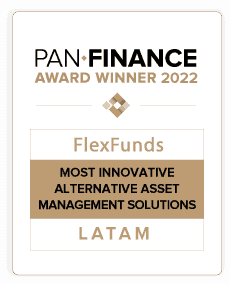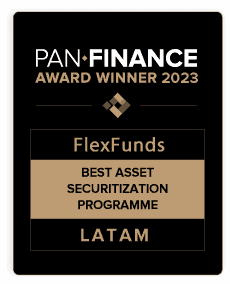- This article delves into how securitized bonds have transformed the financial landscape by providing liquidity and diversification to markets.
- It is mainly aimed at investment managers interested in exploring all the advantages of these financial instruments.
- One way to reach a larger number of potential clients is through asset securitization, a process for obtaining securitized bonds or other assets, carried out by FlexFunds, which turns them into listed products on the stock exchange (ETPs). Contact us for more information!
Securitized bonds have marked a before and after in financial markets, providing liquidity and diversification. Their ability to convert assets such as mortgages, personal loans, credit cards, or leases into listed securities has multiplied the possibilities for both issuers and investors.
The securitization process is responsible for converting assets into listed securities, allowing financial institutions to free up capital and transfer risk-return opportunities to investors.
Securitized bonds are always built and backed by an underlying asset. The most common are MBS – Mortgage-Backed Securities, ABS – Asset-Backed Securities, and others related to credit cards, student loans, etc.
Like any bond, they are divided into different tranches with varying levels of risk and return, such as senior, mezzanine, and equity, allowing investors to select the ones that are most suitable for their portfolios.
The role of securitized bonds in investment strategies
One of the greatest advantages of securitized bonds is their ability to diversify risk, as they are backed by a pool of assets, offering risk diversification compared to investing in a single asset.
Securitized bonds allow investors to access a variety of underlying assets, diversifying their portfolios beyond traditional financial instruments and reducing the specific risk associated with any individual asset class.
Moreover, securitized bonds enable financial institutions to free up capital by selling assets to a Special Purpose Vehicle (SPV) (an entity created specifically to hold the underlying assets and issue bonds, separating the assets from the issuing institution) and issuing bonds, allowing them to finance new operations.
The role of securitized bonds is key in investment strategies because these types of instruments offer higher credit spreads than other fixed-income instruments, resulting in attractive returns for investors while providing diversification and risk management.
Securitized bonds can provide competitive risk-adjusted returns, improving capital efficiency in an investment portfolio.
Additionally, many securitized bonds have active secondary markets, enhancing liquidity and allowing investors to buy and sell these instruments relatively easily and flexibly to adjust their portfolios based on market conditions.
Furthermore, securitized bonds generate regular cash flows from payments on the underlying assets (such as mortgages and loans), providing stable income to investors; and predictable cash flows that can help cover future liabilities, especially in the case of pension funds and insurance companies.
Among the solutions for obtaining securitized bonds or other assets, FlexFunds offers various options that allow for portfolio expansion, and risk diversification.
Securitized bonds can provide competitive risk-adjusted returns, improving capital efficiency in an investment portfolio.
Undoubtedly, in recent decades, we have seen how all these advantages of securitized bonds have revolutionized financial markets, providing more activity and opportunities for certain assets (e.g., mortgages) by transforming credit rights into financial securities issued in capital markets.
They have enabled access to new sources of financing, offering investors access to a wide range of underlying assets and significantly improving market efficiency, reducing financing costs for issuing institutions due to risk diversification and better access to capital, fostering competition in the credit market, which can result in better terms and conditions for borrowers.
However, these financial instruments have also been responsible for amplifying risks in markets. Securitization has allowed issuers to shed risk in their structures, not always with good results, as seen in the 2008 financial crisis, where Collateralized Debt Obligations (CDOs), backed by a mix of assets, including corporate bonds, loans, and other debt securities, played a significant role.
In this case, one of the challenges of asset securitization is the systemic risk and financial contagion it can provoke. The interconnection of financial markets through securitization can increase systemic risk, where problems in one segment can spread to others, and in times of crisis, securitization can amplify financial problems, as evidenced during the 2008 financial crisis.
Among other reasons, due to the moral hazard incurred by financial institutions, which may have incentives to originate riskier loans if they know they can securitize them and transfer the risk to investors.
Asset securitization process
Although there are challenges for issuers and institutional investors in managing these types of financial instruments, the reality is that they have brought about an unprecedented transformation of the financial landscape, improving efficiency, reducing costs, and enabling capital release and better risk management.
For this reason, securitization remains a widely used process that offers all the advantages to investment managers, their retail clients, and, of course, institutional investors.
At FlexFunds, we carry out this procedure very simply:
Step 1: Custom study and ETP design
As multiple types of financial assets can be securitized, it is necessary to analyze each case individually to offer a tailored solution.
At FlexFunds, we gather all the necessary data and work with top-level international providers to coordinate the creation and issuance process of the most suitable listed product (ETP) for the stated needs.
Step 2: Due diligence and engagement letter signing
Once the structure of the product to be issued is defined, FlexFunds’ risk committee proceeds with the study and evaluation of the case in legal terms.
Then, the parties involved sign the engagement letter, a contract that specifies the terms and conditions of the service provided, as well as the scope of FlexFunds’ functions.
Step 3: ETP structuring and document review
During the securitization process, FlexFunds must work closely with the client for the proper development of the necessary documentation that will shape the listed product. Here, the onboarding of the portfolio manager takes place.
When the essential documents of the financial vehicle, such as the series memorandum, the constituting instrument, and the portfolio management agreement, are drafted and reviewed, the structuring is then considered finalized.
Step 4: ETP issuance and listing
In this way, the agreed investment strategy is packaged into an ETP, and all that remains is to proceed with the listing of the securitized asset and generate its corresponding ISIN/CUSIP code for easy distribution.
Step 5: ETP ready for trading via Euroclear
The asset securitization process concludes with ETP issuance and listing, making it ready for distribution.
It should be noted that the issuer of the securities is an Irish SPV created solely for this purpose, and the issuance is backed by the investment strategy itself, which serves as collateral.
Thus, thanks to ETPs, clients benefit from entering growing companies and can access their strategy with a simple purchase operation of securities in Euroclear through their existing brokerage accounts.If you would like to learn more about our ETPs and the asset securitization process, please do not hesitate to request a meeting with the FlexFunds team so that we can resolve all your questions.







